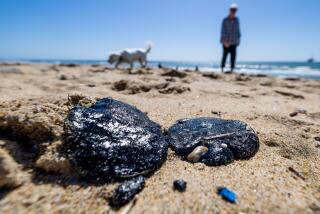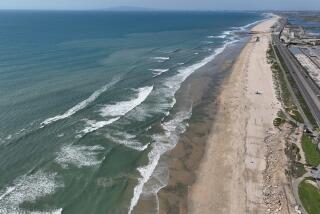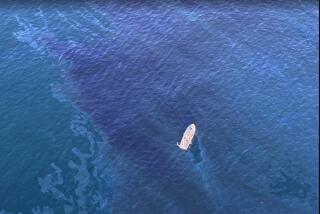O.C. Coastal Ecosystem Has No Room for Error : Environment: Any appreciable oil spill poses a serious threat to the fragile and dwindling wildlife resources here, the experts say.
HUNTINGTON BEACH — Almost every morning since the tanker American Trader poured 394,000 gallons of crude petroleum into the sea, Kennon Cory has gone to the Bolsa Chica wetlands to sit among the thickets of pickle weed and look for oil-soaked birds.
Since he was a child, Cory has been drawn to the quiet of this marshy expanse where scores of rare and migratory waterfowl have found sanctuary in an urban landscape. Protected pockets of nature like Bolsa Chica and Upper Newport Bay shaped Cory’s interests--and future.
Now a graduate student studying ornithology, Cory hurried back to Bolsa Chica after the Feb. 7 spill to patrol with binoculars the mud flats and tiny nesting islands for incoming grebes, Forster’s terns and willets coated with blackish goo from the offshore slick.
“It is very sad that these areas, already under such stress, face this kind of threat,” said the Cal State Long Beach student.
Luckily, the wetlands at Bolsa Chica--like those near Seal Beach, the Santa Ana River mouth and Upper Newport Bay--have not been seriously damaged by the Alaskan crude that blackened miles of shoreline. The timing of the spill, Mother Nature and cleanup efforts have combined to minimize the damage inflicted on the wetlands, tide pools and marine life.
But any appreciable oil is a serious threat to Orange County’s fragile and dwindling wildlife resources. And many naturalists, biologists, bird watchers and fishermen bristle at suggestions that the environmental threat in Orange County has been exaggerated, that it pales by comparison to the 11.2-million-gallon Alaskan oil spill of a year ago.
Wildlife refuges in the county are measured in acres, not miles. And various bird species and marine mammals that live here number in the hundreds, not thousands.
What natural and protected areas do exist on the county’s coast are critical, experts say, because much of the shoreline has been developed or dedicated to high-intensity recreation.
“It makes me so mad when they compare this to Alaska,” said Marielle Leeds, an environmental activist from Laguna Beach. “A few hundred birds here is like thousands of birds up there because that’s all we’ve got. . . . We’re getting attacked from all sides--sewage, oil, malathion spraying and development.”
It is too early to assess the long-term consequences of the spill, biologists say. And perhaps, when all is said and done, the spill may prove to be only a short-term setback for the birds and marine mammals that frequent local estuaries and coastal waters. But some observers contend that the noxious oil came close to destroying what precious little contact Orange County has with a rich natural world of organisms and wildlife that inhabit local wetlands, tide pools and kelp beds.
Years to Dissipate
Jacqueline Michel, a science adviser to the National Oceanic and Atmospheric Administration, said it takes one to three years for the effects of an oil spill to disappear.
As a result, humans as well as birds and marine animals will have to contend with oil on the shoreline.
For example, oil that washed ashore has seeped as deep as three feet into the sand in some areas, according to cleanup officials. As the hot sun heats the sand, the oil will percolate to the surface as tiny pools of fresh tar, meaning thousands of beach-goers who flock each summer to Newport Beach and Huntington Beach may have to watch their step on the sand.
“As soon as people start lying on the beach, they’re going to find out, because their skin will burn,” said businessman Jerry Rusher, who specializes in oil cleanup products.
Swimmers and surfers may have to contend with swirling pools of foamy oil sheen for weeks, although much of the brownish muck should be gone by summer. City officials in Newport are worried about beach erosion because so much of the oil-soaked sand is being hauled away.
Environmentalists are also concerned about what lives under the sand now laced with North Slope crude.
“There is a whole world of organisms that live in the intertidal zone that are going to be affected as oil washes up on the beach,” said Dorothy Green of Heal the Bay, a Santa Monica-based environmental group. “Just think of where the shore birds usually are, following the waves in and out and poking at the beach. Those birds are feeding on those organisms.”
The primary concern, however, remains the wetlands.
“Ninety percent of the wetlands that were here (historically) are gone, and they’re gone forever,” said Pat Baird, an ornithologist at Cal State Long Beach. “If you keep chipping away at habitats, with pollutions, with oil spills . . . there’s just so much these birds can take.”
Said Gordon Smith, chairman of the Huntington Beach Wetlands Conservancy: “Biologists consider the wetlands to be the most productive ecosystems on earth. . . . Coastal property is so valuable, conservationists are fighting to preserve every square foot. Any damage is critical.”
Breeding Concerns
In the initial hours of the spill, state fish and game officials focused on stopping the slick from reaching entrances to wetland areas. Dozens of migrating waterfowl inhabit the estuaries, including the endangered California least tern, a gull-like bird that nests on the sandy islands.
Fortunately, the spill did not occur during the spring, the height of the breeding season for the least tern and most other birds. Studies show that birds ingesting even a small amount of oil may suffer reproductive problems. Because most sea birds produce only a small number of chicks--only one per season for some species--any impact on the breeding rate could have long-term consequences. It could prove disastrous for an endangered species like the least tern.
Thousands of feet of protective boom eventually safeguarded Anaheim Bay, which leads to the Seal Beach National Wildlife Refuge and the Bolsa Chica Ecological Reserve. Newport Harbor also was closed with a series of booms--floats with mesh skirts attached--to keep tainted seawater from filtering into Upper Newport Bay.
At the Santa Ana River mouth, surging tides breached several booms at one stage, prompting officials to erect earthen dikes to stave off the frothy goo that lapped within a few hundred feet of the newly restored Huntington Beach wetlands--a success story in the long, sad decay and disappearance of saltwater marshes.
For years, the 25-acre plot was neglected, but last year enough money had been raised to reclaim the wetlands. Thus, when the spill’s leading edge threatened the area, wildlife biologists, county officials and members of a private conservancy banded together to build berms and dikes.
“We have worked too long to get this far, and we’re determined not to lose this,” said Smith, who spent several sleepless nights monitoring the oil slick’s movement in the river mouth near the wetlands. “We want this to be a place where the sound of birds can be heard again, where people can appreciate what was once a common sight on our coast.”
Efforts to defend the landlocked estuaries generally succeeded as the bulk of oil from the American Trader washed up on the broad sandy beaches of Huntington and Newport. In fact, cleanup officials and some environmentalists cheered the arrival of the lava-like crude on the beaches, contending that it is easier to capture on the flat sand than at sea, or worse yet, to the south in the craggy rocks and coves of Laguna Beach.
Tide Pool Peril
Late last week, a thin brown residue from the dissipating slick worked its way into the rocky tide pools that dot Crystal Cove State Park south of Corona del Mar. Teeming with sea stars, urchins, anemones and crabs, the tide pools are a magnet for wide-eyed schoolchildren.
“It’s one of the richest environments to observe, and it’s one that holds an inherent interest for children,” said Harry Helling, director of education at the Orange County Marine Institute in Dana Point. “All the animals have such strange adaptations that it’s a wonderful lesson in life forms.”
In the shallow waters just offshore from Crystal Cove, scores of skin divers often probe the fish-filled kelp forests which are part of a 1,000-acre undersea reserve.
“At times, diving off Crystal Cove is like diving into an aquarium,” said Frank Wilton, a La Habra electrician who has dived off the Laguna coast for nearly two decades. “The giant kelp lures in all kinds of fish and creatures. The bottom has abalone, crabs and occasionally a lobster or two.”
The ocean and tide pools were posted off-limits over the weekend as dozens of cleanup workers in yellow slickers battled wind and rain to remove the filmy sheen from the rocks.
Scouring oil from rocky coastline, such as that in Alaska’s Prince William Sound, is far more difficult than extracting oil from the kinds of sandy beaches that have so far been blackened in Orange County. Fortunately, the oil washing up near Corona del Mar and as far south as Emerald Bay in north Laguna was not the thick ugly crude that was six inches deep along stretches of Newport Beach.
However, Helling expressed concern about the long-term effect of the spill on intertidal areas like Crystal Cove. Tide pools in Orange County--already impacted by human trampling and pollution--support as little as half to two-thirds the number of species as those in the more remote Channel Islands near Santa Barbara.
“Our tide pools, even here in Dana Point, are not in full, pristine condition to begin with. If you start looking at the full impact of an oil spill in the intertidal (zone), nobody knows the long-term picture,” biologist Helling said. “I would say that the subtle impacts of this could go on for months afterward, at least.”
To assess the oil’s impact at Crystal Cove, state officials said, monthly or bimonthly surveys of marine and plant life will begin immediately.
The kelp--a hearty, fast-growing sea plant--is not expected to be adversely impacted. Visible from Corona del Mar south to Dana Point, the large, thick beds of brown kelp have adapted to increasing levels of ocean pollution, marine experts said.
The prospects for marine mammals are less certain. Dennis Kelly, a marine biologist at Orange Coast College, said the bodies of several sea lions have washed ashore in recent days, but so far none apparently died as a result of the oil spill. Kelly is more concerned about the long-term impact on dolphins, often seen off the Orange County coast.
“I’ve received reports of at least 10 sightings of dolphins in the slicks,” said Kelley, who has studied the mammal in local waters for more than a decade and wants to establish a dolphin research center in Anaheim Bay. He said that if the dolphins ingest too much oil by feeding on contaminated sea life, their livers might stop functioning.
“In time we might see a lot of dead dolphins,” he said. “We just don’t know.”
Depending on the level of exposure, clams and mussels may also become contaminated from the spill, based on studies of shellfish following the Valdez spill in Alaska.
The most visible victims of the spill have been the birds, which have been found injured or dead from Long Beach to south Laguna. More than 360 waterfowl have been treated, and several dozen have been released back into the wild. However, another 299 have died, including 15 brown pelicans, an endangered species, and experts say several hundred more birds may never be found.
How will the Orange County spill effect local shore birds in the future?
“We don’t know what’s going to happen,” said Marge Gibson, director of the Bird of Prey center in Villa Park and a wild bird rehabilitation specialist who spent several months in Alaska monitoring bald eagles after the Valdez spill. “It sometimes takes several years (for problems) to show up.”
Jack Anderson, director of the Long Beach-based Southern California Coastal Water Research Project, said the spill should have no lasting impact on the food chain.
But Pat Baird at Long Beach State is not convinced, saying it’s too early to draw any firm conclusions. “It’s just like caffeine. Fifty percent of the people say that it hurts you, the rest say that it doesn’t.”
Times staff writer Lanie Jones contributed to this story, along with Danica Kirka and Shannon Sands.
Threatened: Orange County Coastal Habitats Wildlife in the aquatic habitats along Orange County’s coast, already suffering from development and other human activities, must now cope with the effects of the 394,000-gallon oil spill from the ruptured tanker American Trader. Wetlands Orange County’s most significant wildlife resources are its coastal estuaries, rich habitats that support a variety of marsh and shore birds. Wetlands near Seal Beach, at Bolsa Chica and near the Santa Ana River mouth and in Upper Newport Bay are important for scores of migrating waterfowl. Much of the spill containment effort was directed at keeping oil out of these areas. Among the endangered species mating in local wetlands is the light-footed clapper rail. Shoreline Much of the oil washed upon the sandy beaches of Huntington and Newport, where it can be mopped up relatively easily and where damage to wildlife was apparently mininmal. However, there is concern about microscopic bacteria and protozoa in the sand that provide food for larger invertebrates, which in turn are eaten by sasnderlings and other shore birds. Grunion came ashore ahead of schedule last week to lay their eggs and died in the oil. Tide Pools With their rough, rocky surfaces, tide pools are much tougher to clean than sandy beaches. Also, they support a wider variety of life: about 200 species in local pools, from octopuses to sea stars. Tide pools are a popular destination for school field trips. Some of the county’s richest, in Crystal Cove State Park on the Irvine Coast, were fouled by oil from the spill. Coastal Waters Most of the wildlife affected by the oil as it drifted on the open waters in the first few days after the spill were birds. S ome birds, such as surf scoters and Western grebes, were vulnerable because they spend much of their time floating on the surface of the water; others,such as the endangered brown pelican, were slicked when they dived in after fish. Some of the oil may have settled to the bottom sediments, where it could affect such bottom-dwelling fish as halibut. Long-term effects on local marine mammals, meanwhile, are difficult to predict.
More to Read
Sign up for Essential California
The most important California stories and recommendations in your inbox every morning.
You may occasionally receive promotional content from the Los Angeles Times.










